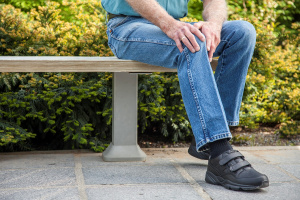Diabetic and Therapeutic Footwear for Neuropathy
Wearing Diabetic Shoes Is A MUST for those with Diabetes
For most of us, a bad shoe day is easily shrugged off. True, you can end up with a blistered heel or a painful arch, but there’s nothing to be alarmed about. However, for people suffering from diabetes, a bad shoe day can be very threatening. Wearing the wrong kind of shoes can lead to serious problems – and sometimes, it can be so serious that an amputation is the only way to mitigate the damage.
Sometimes called extra depth or therapeutic shoes, diabetic shoes are designed to minimize the risk of skin ulcers and breakdown in diabetics…especially those who are already suffering from a foot disease.
Diabetic shoes for Men and Women are different from your traditional footwear in more ways than one. For starters, they are wider and deeper than average. This ensures that the feet can freely move about without brushing against the shoes’ interiors. What’s more, many of these shoes are built in a way that doesn’t include any seams. The average shoe-wearer doesn’t mind seams. But for diabetics, seams can be troublesome as they can rub against the feet.
In addition to a deeper, wider build and some options with seamless interiors, these therapeutic shoes also tend to provide greater stability – reducing the likelihood of twisting the ankle or stumbling.
Propet Cush 'N Foot - Men's Orthopedic Stretchable A5500 Diabetic Shoes
Mt. Emey 9701-V - Men's Extra-depth Athletic/Walking Strap Shoes
Gravity Defyer Men's G-Defy Mighty Walk Athletic Shoes
A Closer Look At The Feet Of A Diabetic
Diabetes is no laughing matter. In the United States alone, 17.9 million men and women battle diabetes. While good blood sugar control can reduce the risk of complications, poorly controlled diabetes render numerous parts of the body (especially the feet) vulnerable against the slightest of accidents.
You see, diabetes can lead to extensive nerve damage known as neuropathy. This condition leaves the foot nerves unable to feel any sensitivity to pain. Fortunately, it doesn’t happen overnight, which means diabetics still have time to prepare and minimize the damage.
Many men and women with diabetes have reported years of experiencing funny, tingling sensations in the feet (tell-tale signs of ailing nerves) before they losing ALL sensation in both feet. Once neuropathy reaches that point however, it’s hard to turn back. Diabetics can step on broken glass, needles, or syringes; break a toe; and suffer from a host of foot injuries…and they won’t feel a thing.
People with neuropathy cannot sense any foreign objects in their shoes at all. James McGuire, Dir. of Leonard S. Abrams Center for Advanced Wound Healing at Temple University\\\\\\\'s School of Podiatric Medicine, once described a patient who didn’t feel a thing after a jack got into his shoe;
He just put the shoe on, stepped down and drove the jack into his foot and walked around all day and ended up with an infection from that.\\\' Dr. McGuire said.
YES, when plagued with diabetes and neuropathy, even the most minor of accidents and injuries can snowball into infections…and even lead to amputation. It’s that serious!
Important Note for fitting Diabetic Shoes
Seek the help of a trained professional to custom-fit your diabetic shoes. Remember, peripheral neuropathy prevents your feet from feeling any sensation – making it impossible for you to tell an improper fit. By enlisting the help of a trained, custom-fitting professional, you ensure that your diabetic shoes are designed with a proper fit and encourages good blood and air circulation. Speaking of design, here are some features your diabetic footwear should have:
- Deep and wide structure – leaving enough space for custom diabetic insoles
- No interior or covered seams that could cause rubbing injuries and skin ulcers
- Roomy toe box so it doesn’t pinch or squeeze your toes
- Adjustable fit – you don’t want it too tight or too loose that it slides around your feet
Other Footwear Products For Diabetics
As much as possible, you want to stick to diabetic shoes. They’re built for comfort and their closed structure prevents stones, thumbtacks, and other small, but dangerous stuff from slipping through. Having said that, you might want something that gives your feet more breathing room. If that’s the case, here are other diabetic footwear and products you want to check out. We have a separate page on diabetic socks.
Diabetic Sandals: To be honest, men\'s and women\'s sandals are not ideal for diabetics. While they are lightweight and comfortable to wear, small stones and debris can easily slip into sandals. For diabetics whose feet can hardly feel anything, that’s a huge risk.
But if you’re not comfortable with shoes and you really must wear sandals, go for a pair that’s durable – one that has a high-grip, multilayer sole; thick pressure sock; and can accommodate molded foot beds / orthotics.
Diabetic Slippers: If you stay at home most of the time, grabbing a pair or two of diabetic slippers could provide relief to your ailing feet. These slippers share the same orthopedic and therapeutic features of diabetic shoes
- Designed from the ground up for protection and support
- Come with spacious toe boxes to minimize the risk of blisters and irritation
- Have removable insoles to cater to your specific orthotic-needs
When shopping for diabetic slippers, you want a pair that’s flexible and comes with an adjustable closure. The adjustable closure will surely come handy since diabetic feet can eventually change in shape and size. You also want diabetic slippers whose outsoles are beefed up with additional traction; pull tabs at its heels; comfortable wool uppers; and sturdy construction.










































































